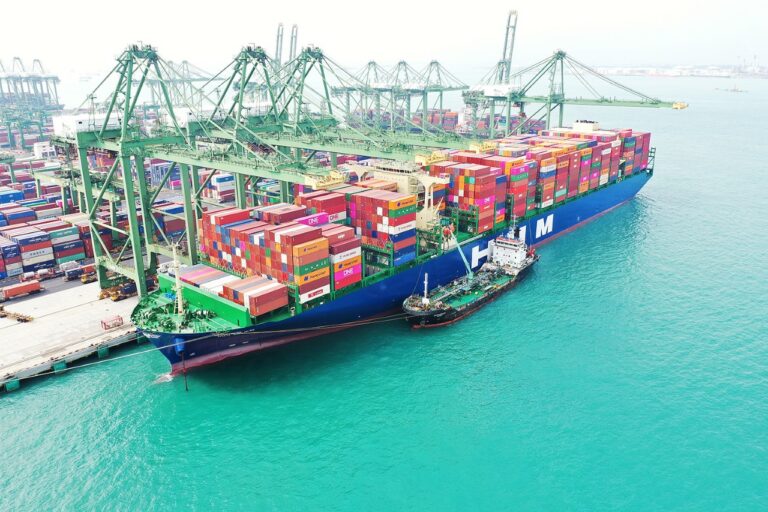The World Shipping Council (WSC) is proposing a solution to the challenge of crafting a global greenhouse gas pricing regulation that encourages investment in green fuels, as the UN International Maritime Organisation works towards its target of achieving net-zero carbon emissions in the shipping industry by 2050 and aims to develop climate regulations by 2025.
 HMM Nuri; Image credit: HMM
HMM Nuri; Image credit: HMM
This proposal, named the WSC Green Balance Mechanism, will be brought to the table during negotiations at the IMO MEPC 81 in March, where member nations prepare to address this conundrum.
“We see the catastrophic effects of climate change every day, and as a significant emitter of greenhouse gases, the shipping industry must do its part and decarbonize by 2050. Container and vehicle carriers are building and already operating vessels that can run on the greenest fuels, but those fuels cost 3 to 4 times more, and the supply of green fuels is only a fraction of what is needed. Global climate regulations are necessary to make it possible for carriers to operate on green fuels, and to incentivize fuel and energy providers to invest in new production capacity,” WSC said.
The WSC Green Balance Mechanism introduces a novel approach to greenhouse gas pricing, aiming to minimize the cost disparity between fossil fuels and green alternatives by implementing a fee structure that reallocates fees from fossil fuels to green fuels, ensuring an equal average fuel cost.
The mechanism incentivizes greater financial allocations for fuels that demonstrate higher greenhouse gas emission reductions throughout their lifecycle. Collected funds are determined by the volume of green fuels used, initially resulting in a relatively low fee during the transition.
The minimum fee, essential to offset price differentials, is directed to ships meeting specific greenhouse gas thresholds, to facilitate the production and use of green fuels at the lowest transportation cost. Emission reduction criteria for price-balancing allocations align with IMO decarbonization requirements, progressively tightening towards the 2050 net-zero goal.
WSC noted that the mechanism is adaptable and fully integrated with a greenhouse gas fuel-intensity standard. It can be used as a targeted greenhouse gas pricing mechanism, or a possible addition to an integrated measure.
Additional fees can be introduced to support climate mitigation initiatives and research projects, ensuring a fair and equitable transition.
The Council explained that the mechanism makes it economically rational and attractive for both ship owners and energy providers to invest in fuels and technologies that deliver deep greenhouse gas reductions from the day the regulation takes effect.
“Existing and soon-to-be delivered dual-fuel ships will be able to operate on the cleanest fuels, rather than having to wait years before economically viable fuels are available. This allows the production of the cleanest fuels to grow more quickly, accelerating economies of scale that will push down the cost of green fuels, getting us to zero in the most economically efficient way possible,” the council added.
CEOs of liner shipping companies agree that collective action would be needed to meet IMO’s decarbonization goals.
“The World Shipping Council’s proposal for the Green Balance Mechanism is a pragmatic step towards sustainable shipping. This greenhouse gas pricing mechanism aims to promote a competitive shift to low-emission fuels, which is consistent with our sustainability measures, our goal to operate a net-zero fleet by 2045, and the shipping industry’s overall commitment to decarbonization. Additionally, it promotes the production of alternative fuels and minimizes the economic burden on all stakeholders, ensuring a level playing field. These are crucial factors for a successful energy transition in maritime shipping,” says Rolf Habben Jansen, CEO of Hapag-Lloyd.
“Climate change is a defining issue of our time, and HMM shares a sustainability vision of the global shipping industry. To achieve net zero emissions by 2050, HMM has focused on enhancing carbon footprint visibility, ordering methanol-powered vessels, and exploring clean energy sources, including biofuels, methanol, and ammonia. We believe the Green Balance Mechanism proposed by WSC is expected to accelerate the industry’s broader transition to carbon neutrality,” says Kyung Bae Kim, CEO of HMM.
“The year 2050 might seem distant, yet in the context of our climate ambitions, it is practically upon us. The IMO is at a crossroad that will determine our ability to decarbonize the shipping industry and achieve net-zero emissions. To get there, we need mechanisms that can bridge the transition from fossil-based to green fuel, and we call on IMO Member States to take decisive actions that reward early adopters by compensating truly green vessels corresponding to their emission’s reductions. This approach is critical for accelerating the retirement of fossil-fuelled vessels,” says Vincent Clerc, CEO of Maersk.
“In an industry as interconnected and global as ours, the power of a coordinated effort in driving change cannot be overstated. X-Press Feeders fully supports WSC’s proposal of a Green Balance Mechanism (GBM) to the International Maritime Organization (IMO) members states and other stakeholders. For both suppliers and customers of the shipping industry to achieve a smooth transition to wider usage of green fuels, the significant financial gap between green fuels and conventional fuels must be addressed,” says Shmuel Yoskovitz, CEO of X-Press feeders.
“The proposed GBM aims to do that at a minimal impact of the industry. We at X-Press feeders, being the first to operate a green feeder network in Europe using methanol-powered vessels, are continuously tackling the challenges of the price gap in keeping our green solutions economically sustainable. The mechanism proposed by WSC helps level the playing field for the green fuel users without over burdening the cost for the conventional fuel users. These are essential stepping stones towards reducing the shipping industry’s carbon footprint and mitigating climate change. By fostering an environment that encourages innovation and investment in green technology, we can set a course towards a sustainable future for global shipping, ensuring it remains a cornerstone of the global trade while protecting our planet for future generations.”
>>> Read full article>>>
Copyright for syndicated content belongs to the linked Source : OffshoreEnergy – https://www.offshore-energy.biz/liner-majors-rally-behind-wscs-ghg-pricing-mechanism/


















![[News] Japan Develops 10nm Nanoimprint Technology, with Potential to Tackle EUV Bottleneck – TrendForce](https://earth-news.info/wp-content/uploads/2025/12/329851-news-japan-develops-10nm-nanoimprint-technology-with-potential-to-tackle-euv-bottleneck-trendforce-360x180.jpg)












